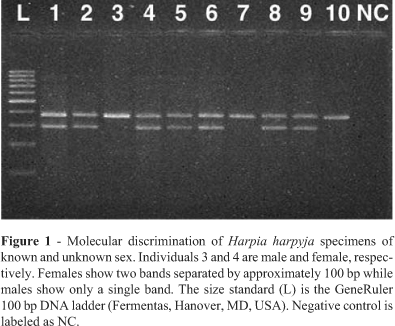We report the characterization and optimization of 45 heterologous microsatellite loci, and the development of a new set of molecular sex markers for the conservation and management of the Neotropical harpy eagle (Harpia harpyja L. 1758). Of the 45 microsatellites tested, 24 were polymorphic, six monomorphic, 10 uncharacterizable due to multiple bands and five did not amplify. The observed gene diversity of the analyzed sample of H. harpyja was low and similar to that of other threatened Falconiformes. While a high proportion of the microsatellite markers were highly variable, individuals of H. harpyja could be differentiated by a joint analysis of just three (p = 2.79 x 10-4) or four markers (p = 2.89 x 10-5). Paternity could be rejected with 95.23% and 97.83% probabilities using the same three and four markers, respectively. The sex determination markers easily and consistently differentiated males from females even with highly degraded DNA extracted from naturally shed feathers. The markers reported in this study potentially provide an excellent set of molecular tools for the conservation and management of wild and captive H. harpyja and they may also prove useful for the enigmatic Neotropical crested eagle (Morphnus guianensis Daudin 1800).
conservation genetics; Harpia harpyja; microsatellites; raptors; sex markers





